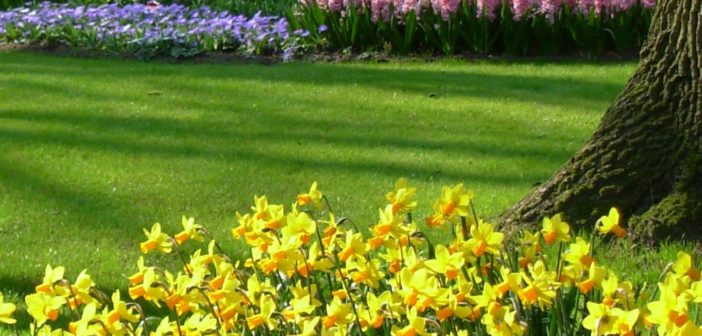Many people take pride in a vibrant, healthy lawn. If your grass still has some of last autumns weeds, has built up a layer of thatch or is riddled with bare spots, it is a good idea to have a plan ready for taking action as soon as the spring weather arrives. These five tips will help you to beautify your lawn for spring so that it will look great throughout the growing season.
1- Test and Amend the Soil
One of the first actions that you should take in order to beautify your lawn for spring is to collect a soil sample and send it to a laboratory for analysis. Amazing Lawns said, “A soil sample provides you with key information about the condition of your soil.” You will get a detailed report about the composition of your soil and the nutrient levels within it. With the information from your soil analysis report, you will then know which type of fertilizer to apply later in the spring and summer. You will also be able to make informed decisions about which type of grass seed to buy and which annual and perennial plants will grow the best in your type of soil.
2- Rake and Aerate the Soil
To get your lawn ready for spring so that the grass can grow, you will also need to remove leftover debris from autumn and winter, explains the University of Michigan Extension Service website. You can use a plastic, wood, bamboo or steel rake and gently rake the debris off of your yard. Removing this debris allows the grass to get more sunlight. It also helps to reduce the risk of mold and mildew growth. Aerating is also important. If your lawn has built up a thick layer of thatch, it the grass may not be getting enough nutrients. It will also be difficult to plant new grass seed if there is thatch in the way. Aerating the soil helps to break up the thatch so that it can decompose and deliver nutrients to the soil. Your lawn will thrive with the influx of nutrients. Take care to note the general conditions and avoid doing any raking or aerating if the yard is saturated or muddy.
3- Apply a Pre-emergent Herbicide
The time to apply an herbicide for weed prevention and control is when the nighttime soil temperatures are 52 to 55 degrees Fahrenheit, explains the University of Minnesota Extension website. In places across the upper Midwest and the Northeast, this is in late April to early May. You can apply a broad-leaf herbicide in mid to late May when the soil temperatures are at or over 55 degrees Fahrenheit. These herbicides are effective against dandelions, thistles and other weeds. If there are only a few scattered weeds in your yard, consider pulling them out manually. This helps to minimize chemical usage on your lawn.
4- Seed the Grass
In most locations, May is the best month to plant grass seed. If your lawn has some bare patches, the seeds will germinate faster in May. You may select a grass seed product that also includes an emergent herbicide so that only the grass grows in the area that you have planted. If your grass is a little thin or you have just pulled out a bunch of weeds and there are bare spots here and there, you could over-seed the grass. This works best if you use a manual caster that can evenly distribute the seeds across your lawn. To prevent birds from eating the grass seed, you can place a thin layer of straw or hay on top of the seeds. Once the seeds have sprouted, the straw or hay can be carefully removed and composted.
5- Spread Compost
If you have a compost bin, May and June are the best months of the year to apply it to your lawn. You can also apply the worm tea or castings from your worm farm at this time. A thin layer of compost is best, especially if you are growing new grass. If you have any flower beds or bushes around the perimeter of your lawn, you can also put some compost or worm tea or worm castings around them.




